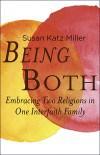
To celebrate today’s release of my book, Being Both: Embracing Two Religions in One Interfaith Family, I am launching a new series on teens and young adults raised in interfaith family communities. These portraits are drawn from interviews and from my survey of 50 young people who attended dual-faith education programs in NY, DC, Chicago and California. Since the survey was anonymous in order to encourage honest answers, I use pseudonyms here (although I am proud to say the book is full of real names). Many of these detailed portraits did not fit into the book, so this is new, bonus material!
Cara: Educated in the Earliest Interfaith Classroom
Cara attended the very first dual-faith education program designed for interfaith children (the program that evolved into The Interfaith Community) in Manhattan in the late 1980s. The daughter of a Christian mother and a Jewish father, she was 8 years old when she started afterschool classes in Judaism and Christianity, co-taught by a Jewish and a Christian teacher. Cara explains that she did not find learning about both religions confusing because “they were taught to me as one emerging from the other chronologically, and the parallels in the religions were presented.”
In college, Cara, like many children in my research who were raised with a dual-faith education, went on to study some of the other religions of the world. She also, like many of these children, attended Jewish services on campus and took part in Jewish social activities through Hillel, the nationwide program for Jewish college students. Often, Cara has had to defend her claim to Judaism, because she would be considered a “patrilineal Jew,” and traditional Judaism holds that the religion is passed only through the mother. She explains, “Conservative Jews tell me all the time I’m not Jewish. They have their rules–that’s fine. I’m culturally Jewish and that’s enough for me.”
Now in her thirties, Cara describes her religious identity as “interfaith.” She is not married, and does not see any particular reason to choose a single faith. She writes that she felt “no need to choose at 8, or 12, or 18” so “why now?” When asked why she chose an interfaith identity, Cara credits both her interfaith education, and her liberal arts education in college. She writes, “once you see the range of religions and ways people live their lives” she felt she could “no longer see any need or purpose to commit or define myself to one.”
Cara continues to attend church on Christmas and Easter, in part because she loves the music. She reports that she also feels comfortable in synagogues, and attends a Reform Jewish synagogue on the High Holy Days. When asked about her concept of God, Cara writes, “there is no god–god is yourself. The mind is a powerful tool, and the power of belief can achieve a lot.”
Cara says she did not experience any disadvantages in being educated in two religions. As for advantages, she appreciated the “double dose of exposure and education” and the fact that she “got to learn twice as much about the world as other kids.” When asked how her interfaith education affects her general outlook on life, Cara writes that it “makes me open-minded to anything, interdisciplinary in a lot I do, open to lots of new cultures, traditions, religions, values.”
Overall, Cara reports that she thinks her parents made a good decision to raise her with both religions. And when asked how she might raise any future children, she writes, “Interfaith—hopefully with strong Jewish exposure.”

